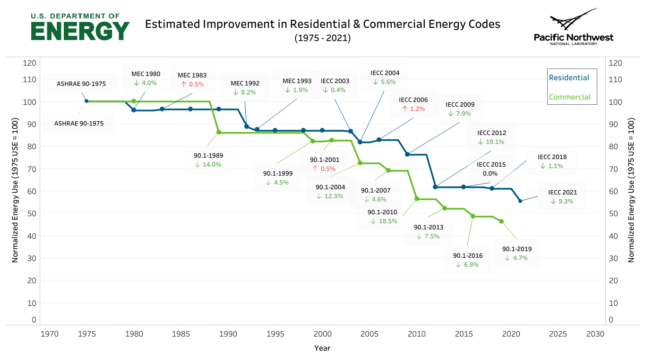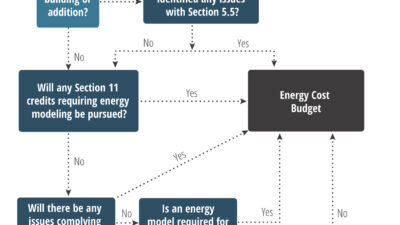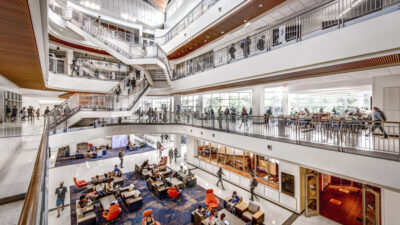Building on the momentum of previous editions, ASHRAE Standard 90.1-2022 is leading the way toward renewable energy and decarbonization in commercial buildings

Learning Objectives
- Understand how ASHRAE goes about updating ASHRAE Standard 90.1: Energy Standard for Buildings Except Low-Rise Residential Buildings, including involving the public and ensuring a transparent process.
- Identify specific areas of Standard 90.1-2022 that have been revised or newly added and recognize how they impact ASHRAE’s different compliance paths.
- Webcast provides a demonstration and case study showing advantages of Git for PLCs software.
ASHRAE 90.1 insights
- The purpose of this article is to present and discuss content revisions that appear in ASHRAE Standard 90.1: Energy Standard for Sites and Buildings Except Low-Rise Residential Buildings.
- The updates demonstrate how the ASHRAE Standard 90.1 Technical Committee continues to partner with industry stakeholders to drive improvements in the efficiency of HVAC equipment and processes used in buildings.
- This shows how ASHRAE Standard 90.1 is moving ahead into new territory — forward-looking compliance paths, expanded design approaches on carbon reduction and enhanced credits for site renewable energy.
 The 2022 updates to ASHRAE Standard 90.1: Energy Standard for Buildings Except Low-Rise Residential Buildings are sweeping to say the least. If you review the addenda to the ASHRAE 90.1-2019 version, you will see that the scope of changes appearing in the 2022 version are significant: modifications and improvements to the existing language coupled with completely new material.
The 2022 updates to ASHRAE Standard 90.1: Energy Standard for Buildings Except Low-Rise Residential Buildings are sweeping to say the least. If you review the addenda to the ASHRAE 90.1-2019 version, you will see that the scope of changes appearing in the 2022 version are significant: modifications and improvements to the existing language coupled with completely new material.
The updates demonstrate how ASHRAE’s Technical Committees continue to partner with industry stakeholders to drive improvements in the efficiency of heating, ventilation and air conditioning (HVAC) equipment and processes used in buildings.
Many of the additions in the 2022 standard are appearing for the first time in a minimum-efficiency U.S. code or model energy standard. One of the key strengths is providing tools to the design and construction community. The use of these tools will result in buildings that are more efficient and lower carbon emissions.
ASHRAE 90.1 is the de facto standard for energy efficiency in buildings. It is a “code-ready” standard, meaning local jurisdictions can tailor it and use it as their energy code. The standard has been around since 1975 and has been adopted in the U.S. and around the globe.
According to the Building Codes Assistance Project (BCAP), 38 states have adopted ASHRAE 90.1. Also, international energy standards — very close in content and scope to Standard 90.1 — are used in India, Canada, Mexico, Dubai, Singapore, Ireland, Hong Kong and other locations.
Finally, in addition to being a template for municipal and state codes, it is also an integral part of the Green Building Initiative – Green Globes and the U.S. Green Building Council LEED, which is the most widely used green building rating system.
Integration into other codes and guidelines is a big part of why the standard is so widely used. For example, ASHRAE 90.1 is used as a starting point or basis for most building energy code requirements in the United States, such as the International Energy Conservation Code, which uses 90.1 as the basis for compliance. Additionally, under the United States Energy Policy Act of 2005. In 2009, ASHRAE 90.1 was mandated to be used by federal agencies as the minimum energy efficiency requirement for new federal buildings.

What has changed in ASHRAE 90.1-2022?
In developing the 2022 edition, ASHRAE followed the processes and procedures that they have for all the past versions. But for Standard 90.1-2022, there are significantly more content additions and revisions. Here are 10 changes engineers should pay attention to.
1. Mechanical system performance path rating (MSPR) method
One of the most important changes to the ASHRAE 90.1-2022 is the introduction of a new compliance path, MSPR, included in Chapter 6. HVAC systems that are allowed to use this approach do not have to meet all of Section 6 prescriptive requirements.
To illustrate this, if an HVAC system is designed without the required outdoor air economizer, it can still comply by using higher efficiency cooling systems or by reducing fan energy as compared to a reference system. The in-depth engineering and calculations are contained in a completely new Normative Appendix L, where the terms total system performance rating (TSPR), TSPRp (proposed) and TSPRr, (reference building) are used.
TSPR is a ratio that compares the annual heating and cooling load of a building to the annual energy consumed by the building’s HVAC system. TSPRp is used for the proposed design; TSPRr defines the rating for the reference building the methodology behind this new compliance path has similarities to the 90.1 Normative Appendix G, Performance Rating Method. They both use a baseline (reference) and proposed building models that are used for energy simulation. Both paths also incorporate predefined equipment efficiencies and system control.

However, there are significant differences between the two. For example, Appendix L is used only for comparing a reference and proposed design and does not allow HVAC system efficiency trade-offs with building envelope, plug loads or lighting systems. These types of trade-offs are allowed in the Appendix G compliance path.
Using the Appendix L compliance path also streamlines the energy modeling process. One example is using simplified thermal blocks (rectangle, L-, H-, U- or T-shape) in the energy model. Where actual building shape does not match these predefined shapes, simplifications are permitted. Also, Appendix L provides detailed design parameters on efficiency and other operational characteristics of the equipment and systems.
To illustrate this, tables in Appendix L define many of the HVAC system parameters, including fan control, minimum zone airflow fraction, occupied outdoor air, energy recovery ventilator, condenser heat rejection, cooling pump (primary) power, chilled water temperature and many others. Each one of these parameters has numerical values and text information.
The big idea behind these data is to build a reference model using predefined values, resulting in a straightforward modeling process, minimizing time and effort in calculating energy use. After the energy performance of the proposed design is complete, the final part of the process gets underway: using the mechanical performance factor (MPF).
2. Climate zone and building type
In most buildings, these variables have the greatest impact on energy consumption.. This is where MPF comes in. The Pacific Northwest National Laboratory (PNNL) developed an analysis and recommendation report that introduced MPF. The U.S. Department of Energy developed Commercial Reference Buildings, which is an analysis for reference buildings. These reference buildings are instrumental in energy modeling and provide complete descriptions for building energy analysis.
In calculating MPF, PNNL revised the HVAC system parameters for each of the building prototypes, with the intent of generating energy modeling parameters that are just “good enough” — minimally code compliant. The TSPR calculation includes the MPF factor in verifying the proposed system has greater efficiency than the reference system. (TSPRp must be greater than the TSPRr, which is divided by the MPF). It is a simplified performance trade-off method for HVAC systems where no building trade-offs are needed.
3. MPF tables
ASHRAE Standard 90.1 also includes MPF tables for site energy, source energy and carbon emissions. The addition of MPF allows for an expanded performance-based approach that includes credits for renewable energy sources and reduced carbon emissions.
4. Modeling at part-load
In addition to renewable energy and carbon emission calculations, ASHRAE has incorporated detailed data on modeling chiller performance at part-load. When modeling energy performance of air- and liquid-cooled chillers, the energy modeling professional requires several input parameters including chiller full-and part-load performance.
Some of these data are not available when the energy modeling process starts. This requires the use of predefined curves that are integrated into the simulation software. This results in inconsistent calculations from project to project for energy performance. To tackle this problem, a new Appendix J was added to the 2022 standard. This appendix includes fit curves developed by PNNL for different types and sizes of air- and liquid-cooled chillers. This approach creates a consistent methodology when modeling energy performance of air- and liquid-cooled chillers.

The following data comes from Normative Appendix J in ASHRAE 90.1-2022. It includes the values and the calculation methodology for the performance curves, including coefficients for cubic polynomial, quadratic and polynomial equations, applicable to the following chillers:
-
Air-cooled.
-
Liquid-cooled positive displacement.
-
Liquid-cooled centrifugal.
Each set of performance curves includes:
-
EIR-f-T: Energy-input-ratio modifier as a function of temperature.
-
EIR-f-PLR: Function of a chiller’s part-load ratio (cubic polynomial equation).
-
CAP-f-T: Capacity modifier as a function of temperatures.
5. Building envelope
The envelope will undergo fewer modifications over the life of a building when compared to HVAC and lighting systems. Previous editions of Standard 90.1 allowed for energy consumption trade-offs between systems and the building envelope components.
These trade-offs now have a backstop, limiting the amount that can be used for the envelope. ASHRAE received comments from different jurisdictions that led up to this revision. The concern is building envelope will be in place for much longer, increasing long-term energy use.
The 2022 edition also has several new technical requirements for the envelope such as thermal bridging, insulated metal panels, wall solar reflectance and roof replacement. Other envelope categories have a direct positive effect on HVAC system energy use: air leakage requirements and envelope commissioning. Increasing the integrity and thermal performance of a building’s envelope will reduce overall energy use and increase occupant comfort.
6. Mechanical efficiency tables and system definitions
The efficiency tables in Standard 90.1 list the minimum energy efficiency requirements of HVAC and other equipment types. The metrics apply to specific equipment types (e.g., water-cooled chillers, packaged air conditioning units, heat rejection equipment) and define how the metrics are used in determining compliance to the standard. As performance of HVAC equipment continues to improve and new design approaches are developed, the metrics and how they are used in the different compliance paths have evolved resulting in more precise results from the calculations.
ASHRAE 90.1-2022 continues this by departing from simpler, but less accurate, metrics. There are different reasons for this evolution. One is using metrics that more closely match the performance characteristics obtained from equipment testing. Another is using a more realistic frequency of outside air temperatures, generating performance results that are specific to the project’s climate zone. To illustrate this, the energy efficiency ratio metric has evolved into integrated energy efficiency ratio, which includes part-load equipment performance.
The 2022 edition also has several updates to the parameters and applicability of HVAC systems and controls such as demand control ventilation, setback controls, garage exhaust systems and controls, ceiling fan efficiencies, dehumidification control, energy recovery ventilation requirements, dedicated outside air system exemption and expanded airside economizers.
7. Energy credits
Energy credits are new to ASHRAE 90.1-2022, not appearing in any of the previous editions. In addition to meeting all base energy code requirements, energy credits are an additional prescriptive method for demonstrating compliance with an estimated 5% additional energy cost savings. Using energy credits provides flexibility for the building designer. The 2022 edition lists specific measures that correspond to the credits., including measures on energy efficiency, renewable energy and load management. PNNL published a report in 2022 analyzing the energy and cost savings from the energy credits that are in the new standard..
8. Lighting
In addition to the indoor agricultural grow lighting, other significant changes to lighting show up in ASHRAE 90.1-2022. The definition of exterior lighting now extends to the building site. This change makes a big difference in the energy consumption that is calculated for the building. In the previous editions of Standard 90.1, site lighting was defined as lighting fed from an electrical panel that is a part of the building. So, any parking lots, walkways and other exterior lighting would not be included unless it came from the building.
Also, maximum power metrics for exterior lighting were significantly reduced in ASHRAE 90.1-2022, taking into consideration the use of LEDs and improved design approaches. Finally, there are several revisions to lighting control, lighting power density, daylighting and the addition of energy credits specific to lighting.
9. Expanding use of renewable energy
ASHRAE 90.1-2022 has a minimum prescriptive requirement for on-site energy using technologies such as photovoltaic panels and wind turbines. As discussed for lighting, expanding the boundary of the project also benefits on-site renewable energy systems which can now be used as credits toward energy usage, as outlined in National Renewable Energy Lab’s Operational Emissions Accounting for Commercial Buildings.
10. Commitment to reducing greenhouse gas (GHG) emissions
Energy efficiency for commercial buildings is the primary purpose of ASHRAE Standard 90.1. Energy use in buildings is the greatest source of GHG in the commercial building sector and ASHRAE is the tip of the spear in improving efficiency and curbing energy consumption.
To demonstrate this, the DOE estimates the 2022 edition will reduce energy costs 19% over the 2019 edition and 48% compared to the 2004 edition. ASHRAE established the ASHRAE Taskforce on Building Decarbonization that focuses on decarbonization in commercial buildings. This task force has set goals for achieving net zero GHG emissions for the building sector from 2030 to 2050.
The 2022 edition now includes a methodology for using site and source energy cost in addition to carbon emission factors. This gives local jurisdictions the ability to judge building energy performance using these new factors. For compliance purposes, this method is meant to be used voluntarily by local jurisdictions where using a carbon emissions metric is not in conflict with U.S. federal law.
How does ASHRAE 90.1 remain relevant?
Why has ASHRAE 90.1 been adopted so widely and rooted in other programs? The answer is subjective but the underlying facts provide validation:
ASHRAE’s “Standards Strategic Plan” ASHRAE Strategic Plan 2019-2024 provides details on the development of new standards. The strategic plan includes the language to “… provide consistent and forward-looking guidance to the standards committee to ensure that the efforts of the society have the largest possible impact on our built environment while considering the time and effort associated with their development and maintenance.”
The primary strategies from the plan are:
-
Anticipate industry needs.
-
Maintain leadership in standards.
-
Collaborate with others.
-
Promote adoption of ASHRAE standards.
-
Promote international use of ASHRAE standards.
ASHRAE 90.1 has been written and updated over the decades by experts in the building energy efficiency field. Being on an ASHRAE Technical Committee requires an unbiased, technically motivated approach that does not favor certain products or services, steering clear of any potential conflict of interest.
ASHRAE’s Technical Committees develop recommendations for several ASHRAE publications, including the Standard 90.1. Built into this development process is inviting the public to have a say in the documents — no affiliation to ASHRAE is required. This is important because anyone showing interest can download, free of charge, the proposed addenda and submit suggestions. All comments received during the review period are addressed. Ensuring a transparent process by inviting the public to participate reinforces ASHRAE’s commitment, “to serve humanity by advancing the arts and sciences of heating, ventilation, air conditioning, refrigeration.”

A new edition of the standard is updated and published every three years, typically for content updates based on things such as new design concepts and equipment efficiency improvements. A synergistic relationship with forward thinking professionals (who are also committed to lowering energy and resource consumption in buildings), is an important part of ASHRAE’s success. This is manifested by consistently debuting new energy efficiency criteria and compliance methodologies. These actions maintain the standard as the flagship of energy standards. According to the DOE, the last three editions (2013, 2016, 2019) have averaged 6% to 7% overall energy savings per edition. The 2022 edition will have energy savings of 14%.
While the revisions are a representation of ASHRAE’s ambitious goals to reduce energy consumption in commercial buildings, ASHRAE is making strides beyond building energy and including reduction of carbon emissions and the use of on-site renewable energy. Lowering carbon emissions by using renewables and energy efficiency strategies in commercial buildings is vital to meeting net zero goals.
Online tools
For a complete listing of addenda, refer to ASHRAE’s website for a list of the addenda ASHRAE Standards and Guidelines Addenda.
It is telling when the ASHRAE Journal has articles on the new 2022 Standard seven months in a row. Each of these articles is an excellent source of information on different aspects of the Standard
Changes to Envelope Requirements in ANSI/ASHRAE/IES Standard 90.1-2022, By Rahul Athalye; Jonathan Humble, Faia, Member ASHRAE; Chris Mathis, Fellow/Life Member ASHRAE; Ben Meyer; Len Sciarra, Aia, Member ASHRAE; Mike Tillou, P.E., Member ASHRAE; Robert Zabcik, P.E., Associate Member ASHRAE, May 2023 Changes to Envelope Requirements in 90.1-2022
Thermal Bridging Requirements in Standard 90.1-2022, By Len Sciarra, Aia, Member ASHRAE; Rahul Athalye; Jonathan Humble, Faia, Member ASHRAE; Chris Mathis, Fellow/Life Member ASHRAE; Ben Meyer; Mike Tillou, P.E., Member ASHRAE; Robert Zabcik, P.E., Associate Member ASHRAE, June 2023 Thermal Bridging Requirements in Standard 90.1-2022
What’s New in Standard 90.1-2022—Mechanical Updates, Part I: HVAC&R and Service Water Heating, By Richard Lord, Fellow ASHRAE and Donald Brundage, Member ASHRAE, July 2023 90.1-2022 Mechanical Updates, Part I
Energy Credits—A New Way to Save In ASHRAE/IES Standard 90.1-2022, Reid Hart, P.E., Life Member ASHRAE; Doug Maddox, P.E., Member ASHRAE; Michael Tillou, P.E., Member ASHRAE; Michael Rosenberg, Fellow ASHRAE, August 2023 Energy Credits – A New Way to Save in 90.1-2022
Lighting Changes in ASHRAE/IES Standard 90.1-2022, By Michael Myer; Kelly Seeger, Associate Member ASHRAE, September 2023 Lighting Changes 90.1-2022
What’s New in ASHRAE/IES Standard 90.1-2022—Mechanical Updates, Part II: Mechanical System Performance Rating Method, By Supriya Goel, Associate Member ASHRAE; Reid Hart, P.E., Life Member ASHRAE; Michael Rosenberg, Fellow ASHRAE, October 2023 90.1-2022 Mechanical Updates, Part II
ASHRAE/IES Standard 90.1-2022 Performance Path Changes, By Jason Glazer, P.E., BEMP, Member ASHRAE; Maria Karpman, BEMP, Member ASHRAE; Itzhak Maor, Ph.D., P.E., Life Member ASHRAE; Michael Rosenberg, Fellow ASHRAE; Michael Tillou, P.E., Member ASHRAE; Jérémy Lerond, Associate Member ASHRAE, November 2023 90.1-2022 Performance Path Changes



